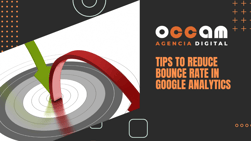Index Content
The bounce rate represents the percentage of users who visit a website and leave without interacting with the content. This is due to the fact that visitors do not find our website interesting or have not found what they expected. The higher the bounce rate, the worse the user interaction is. It is an essential metric to evaluate the efficiency of a digital marketing action. It serves as an input to know what needs to be improved and how to attract the attention of the audience.
Every time a visitor enters the website and does not continue browsing, a bounce is counted. It is important to measure and analyse the data to study the objectives. Tracking helps the company to obtain information about its calls to action and increase conversion. For example, the bounce rate in Google Ads is a direct loss of money and increases the cost per lead (CPL).
Reasons that cause a high bounce rate
- Error in the code: If the website has errors in the tracking codes, the bounce rate will increase. Web analytics tools work thanks to these codes, which must be installed in the source code.
- Single page: If the website has only one page, it will be more difficult for the user to browse our site and to do so for a longer period of time. The permanence of the visits must be analysed to measure their satisfaction and behaviour.
- Content without value: Many companies focus on optimising their website to achieve a better positioning. This is detrimental to the contents because they provide them with irrelevant information for the user. In this way, the visitor loses interest and the bounce rate increases.
- Bad website design: The design of the page will be decisive for the user's navigation. The designer must pay special attention to internal communication, appearance, SEO positioning and loading speed.
- Phantom visits: These are fake visits that come from robots to alter the measurement data. Spammers use programmes so that, without visiting your page, the hits they send are counted. In this way, they increase the referral traffic. Phantom visits can also come from organic traffic, social networks or events.
- Orphaned pages: An orphaned URL has no internal links that direct the user elsewhere. This will make it difficult for the visitor to navigate the website freely.
Bounce rate and exit rate
These two values can be confused, but they are totally different. The bounce rate indicates the percentage of people who have left the website without visiting any page: they arrive at the page, see it and "bounce". On the other hand, the exit rate shows the percentage of users who have visited a page and have left the website from that place. That is, it indicates that this was the last page they saw before leaving our site, but that does not mean that it was the only one. Therefore, the number of abandonments should be equal to the number of visits.
There is another difference between these two concepts: the way they are calculated. The bounce rate is calculated on the total number of visits that arrive at a specific page; the landing page. On the contrary, the exit rate is known by dividing the number of abandonments of a specific page by all the visits of the website regardless of the page of origin.
Positive bounce rate
It is important to know the values of the bounce rate of our website in order to optimise it based on the data provided. This information is valuable for inbound marketing as it focuses on the user experience. There are some factors that indicate whether a high bounce rate is positive and how we can benefit from it:
- Source of the bounce rate: If the highest bounce rate comes from a certain keyword or third party link, it is a signal to review the SEO strategy. It indicates that we should know how we link to our content on sites like Facebook or Twitter. It provides information to our marketing campaign so it is not entirely negative.
- Landing page: If our website is located on a landing page and the bounce rate is high, it is not negative. There is no other place to go after it, but you get visitors.
- Users know your content: If your site has regular publications, your users know when and where to go. In this case, the bounce rate would not be negative either, as they go directly to the content they want to consume and then leave the website.
5 tools to measure the bounce rate
- Google Analytics: This tool is the most widely used in business web analytics. It uses a simple formula to calculate this percentage, offering results on different bounce rates. It focuses on the origin of the visits to offer a complete perspective on the behaviour of users. It shows the results of the overview of the audience, the different channels (social networks, ads and third parties), traffic from sources and media and the rate of each page.
- Clicky Analytics: Its operation is similar to that of Google, but its measurement considers that if a user spends 5 minutes on a page and then leaves it is not a bounce. It has a free version and two plugins adaptable to WordPress.
- StatCounter: This software is ideal for websites with low traffic that are looking to make a small investment, but obtain reliable results. It is also adaptable to any device.
- Open Web Analytics: This tool is characterised by its open code, which means that it can be used professionally by collaborating with a donation. Its format is similar to Google's, but it includes a coloured map to track users.
- Matomo: Its main advantage is that it is able to protect and store data on its own server, it is open source and has different plugins to adapt it to your preferences.
5 keys to reduce the bounce rate
- Avoid pop-ups: The user experience is frustrated with the appearance of invasive pop-ups due to their capacity to distract and demand actions. Although the use of pop-ups can be useful, for example, to generate sales; other alternatives such as mailing campaigns or banners fulfil the same function and are less intrusive.
- Use meta descriptions: This information appears below the title of our page in Google. A good description of the site can attract a quality audience.
- Use keywords: To reduce the bounce rate, find out which keywords generate the most traffic and use them to create quality content for users.
- Make it readable: It is not enough to create quality content, it must also be easy to read. Texts must have images, lists, quotes, titles... A well-structured design will invite the visitor to stay.
- Test it with A/B testing: You can test the modifications made to your website. With this testing campaign, you can base your decisions on objective data. There are various tools to do this, such as AB Tasty or Google Optimize.






